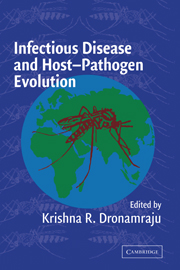Book contents
- Frontmatter
- Contents
- List of Contributors
- Introduction
- PART ONE J. B. S. HALDANE
- PART TWO MALARIAL PARASITES
- PART THREE OTHER PARASITES
- 7 Influenza Evolution
- 8 Free-Living to Freewheeling: The Evolution of Vibrio cholerae from Innocence to Infamy
- 9 Evolutionary Dynamics of Daphnia and Their Microparasites
- 10 Human Susceptibility to Visceral Leishmaniasis (Leishmania donovani) and to Schistosomiasis (Schistosoma mansoni) Is Controlled by Major Genetic Loci
- PART FOUR GENETIC AND EVOLUTIONARY CONSIDERATIONS
- Index
- Plate Section
- References
7 - Influenza Evolution
Published online by Cambridge University Press: 10 August 2009
- Frontmatter
- Contents
- List of Contributors
- Introduction
- PART ONE J. B. S. HALDANE
- PART TWO MALARIAL PARASITES
- PART THREE OTHER PARASITES
- 7 Influenza Evolution
- 8 Free-Living to Freewheeling: The Evolution of Vibrio cholerae from Innocence to Infamy
- 9 Evolutionary Dynamics of Daphnia and Their Microparasites
- 10 Human Susceptibility to Visceral Leishmaniasis (Leishmania donovani) and to Schistosomiasis (Schistosoma mansoni) Is Controlled by Major Genetic Loci
- PART FOUR GENETIC AND EVOLUTIONARY CONSIDERATIONS
- Index
- Plate Section
- References
Summary
THE VIRUS
The influenza viruses are classified in three genera of the family Orthomyxoviridae. The genera are referred to as “types” A, B, and C. The genome, about 14 KB in size, has eight single-stranded RNA segments of negative sense (seven segments in influenza C viruses). The influenza A genome encodes three polymerase proteins (PB1, PB2, and PA); two major surface glycoproteins, hemagglutinin (HA) and neuraminidase (NA); three structural proteins (NP, M1, and M2); and two non-structural proteins involved in nuclear export (NS1 and NS2) (Lamb, 1989). An eleventh open reading frame recently discovered within PB1 appears to code for a protein involved in host cell apoptosis (Chen et al., 2001).
Two surface glycoproteins have been the object of most evolutionary studies of influenza. Hemagglutinin (HA) is involved in binding to host cell surface receptors. Neuraminidase (NA) is necessary for release of daughter virions from host cells. These proteins protrude from the viral envelope and are exposed to host immune defenses. While the HA is the primary target for neutralizing antibodies, antibodies against NA also may reduce occurrence and severity of illness, and possibly prevent infection if present at high titer. The hemagglutinin esterase (HE) in influenza C assumes the functions of both HA and NA. Broad reviews of influenza biology can be found in Murphy and Webster (1996) and Glezen and Couch (1997).
SUBTYPES
Considerable genetic diversity exists among avian influenza A viruses (Webster et al., 1992).
- Type
- Chapter
- Information
- Infectious Disease and Host-Pathogen Evolution , pp. 175 - 197Publisher: Cambridge University PressPrint publication year: 2004
References
- 1
- Cited by



